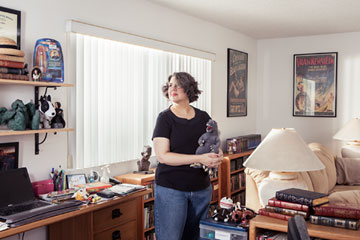
Myers, in her office in Fullerton, Calif., now writes books about the autism spectrum.
(2 of 4)
People with autism are really good at seeing details. Traditionally researchers have characterized an acute attention to detail as "weak central coherence"--a deficit. More informally, you could say that autistic people have trouble putting together the big picture or that they can't see the forest for the trees. Personally, I prefer the more neutral term local bias, because the autistic brain can be very good at seeing the trees.
Studies have repeatedly shown that people with autism perform better than neurotypicals (that is, people whose brains function in a more typical fashion) on embedded-figure tests--a variation on the old something's-hidden-in-the-picture game. This is certainly true for me. Several years ago, I took a test in which I had to look at large letters that were composed of smaller, different letters--for instance, a giant letter H that was built out of tiny F's. I then had to identify either the big letter or the little letter. I was much faster at identifying the little letters, a result that's far more common among autistics than among neurotypicals.
Perhaps this is why in my work with animals I can immediately spot the paper cup or hanging chain that's going to spook the cattle, while the neurotypicals all around me don't even notice it.
My tendency to see details before I see the big picture has always been a central feature in how I relate to the world. When I was a child, my favorite repetitive behavior was dribbling sand through my hands. I was fascinated with the shapes; each grain looked like a tiny rock. I felt like a scientist working with a microscope.
As I grew older, I learned to turn that way of thinking to my advantage. For my undergraduate honors thesis, I wanted to explore the subject of sensory interaction. How does a stimulus to one sense, like hearing, affect the sensitivity of other senses? I gathered more than 100 journal papers. Because my thinking is totally nonsequential, I had to develop a way to make sense of the research. Ultimately, I numbered every journal article, typed up the major findings on separate slips of paper and then organized those strips by topic on a huge bulletin board. In the end, after I had finished sorting all the strips of paper into different categories of information, I began to see how all the pieces fit together to form larger concepts.
The same was true for Michelle Dawson, the University of Montreal researcher who thought to question the conventional wisdom on autistic intelligence in the 2007 paper mentioned earlier. Dawson is autistic, and I think she was more likely to make her conceptual leap because she possessed a fine attention to detail. "Dawson's keen viewpoint keeps the lab focused on the most important aspect of science: data," Laurent Mottron, her frequent collaborator and the director of the autism program at Rivière-des-Prairies, wrote in a 2011 article in Nature. When other researchers look at her data about autistic strengths and say, "It's so good to see something positive!" she answers that she doesn't see it as positive or negative: "I see it as accurate."
ASSOCIATIVE THINKING
